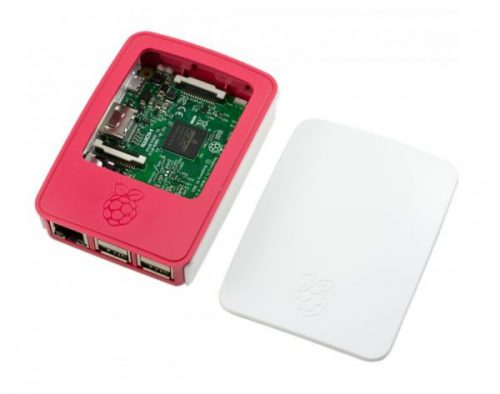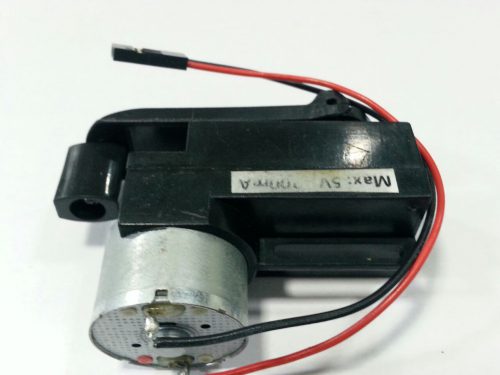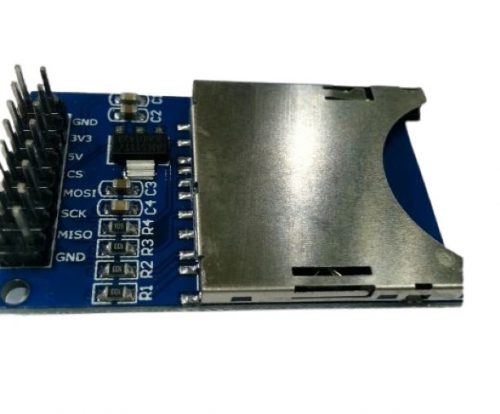-
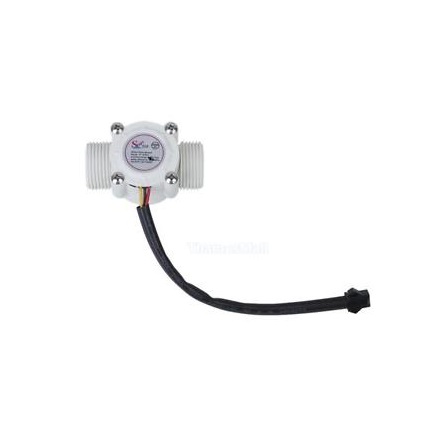 This sensor sits in line with your water line and contains a pinwheel sensor to measure how much liquid has moved through it. There's an integrated magnetic hall effect sensor that outputs an electrical pulse with every revolution. The hall effect sensor is sealed from the water pipe and allows the sensor to stay safe and dry. The sensor comes with three wires: red (5-24VDC power), black (ground) and yellow (Hall effect pulse output). By counting the pulses from the output of the sensor, you can easily calculate water flow. Each pulse is approximately 2.25 milliliters. Note this isn't a precision sensor, and the pulse rate does vary a bit depending on the flow rate, fluid pressure and sensor orientation. It will need careful calibration if better than 10% precision is required. However, its great for basic measurement tasks!
This sensor sits in line with your water line and contains a pinwheel sensor to measure how much liquid has moved through it. There's an integrated magnetic hall effect sensor that outputs an electrical pulse with every revolution. The hall effect sensor is sealed from the water pipe and allows the sensor to stay safe and dry. The sensor comes with three wires: red (5-24VDC power), black (ground) and yellow (Hall effect pulse output). By counting the pulses from the output of the sensor, you can easily calculate water flow. Each pulse is approximately 2.25 milliliters. Note this isn't a precision sensor, and the pulse rate does vary a bit depending on the flow rate, fluid pressure and sensor orientation. It will need careful calibration if better than 10% precision is required. However, its great for basic measurement tasks! -
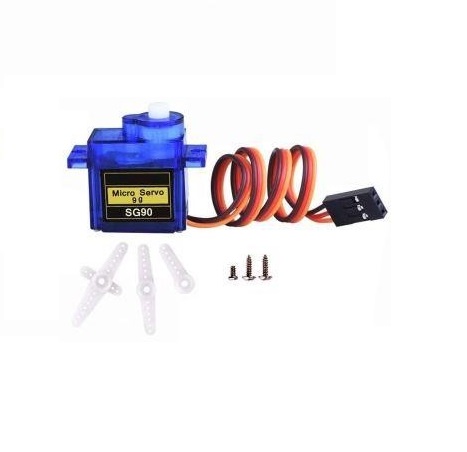 Tiny and lightweight with high output power. Servo can rotate approximately 180 degrees (90 in each direction), and works just like the standard kinds but smaller. You can use any servo code, hardware or library to control these servos. Good for beginners who want to make stuff move without building a motor controller with feedback & gear box, especially since it will fit in small places. It comes with a 3 horns (arms) and hardware. Specifications • Weight: 9 g • Dimension: 22.2 x 11.8 x 31 mm approx. • Stall torque: 1.8 kgf·cm • Operating speed: 0.1 s/60 degree • Operating voltage: 4.8 V (~5V) • Dead band width: 10 µs • Temperature range: 0 ºC – 55 ºC
Tiny and lightweight with high output power. Servo can rotate approximately 180 degrees (90 in each direction), and works just like the standard kinds but smaller. You can use any servo code, hardware or library to control these servos. Good for beginners who want to make stuff move without building a motor controller with feedback & gear box, especially since it will fit in small places. It comes with a 3 horns (arms) and hardware. Specifications • Weight: 9 g • Dimension: 22.2 x 11.8 x 31 mm approx. • Stall torque: 1.8 kgf·cm • Operating speed: 0.1 s/60 degree • Operating voltage: 4.8 V (~5V) • Dead band width: 10 µs • Temperature range: 0 ºC – 55 ºC -
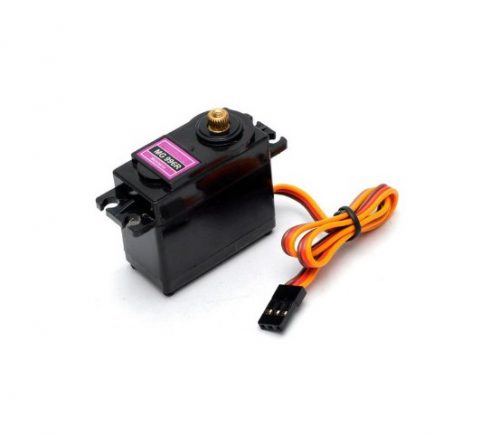 Specifications • Weight: 55 g • Dimension: 40.7 x 19.7 x 42.9 mm approx. • Stall torque: 9.4 kgf·cm (4.8 V ), 11 kgf·cm (6 V) • Operating speed: 0.17 s/60º (4.8 V), 0.14 s/60º (6 V) • Operating voltage: 4.8 V a 7.2 V • Running Current 500 mA – • Stall Current 2.5 A (6V) • Dead band width: 5 µs • Stable and shock proof double ball bearing design • Temperature range: 0 ºC – 4.8 V a 7.2 V – 900 mA (6V) double ball bearing design 55 ºC
Specifications • Weight: 55 g • Dimension: 40.7 x 19.7 x 42.9 mm approx. • Stall torque: 9.4 kgf·cm (4.8 V ), 11 kgf·cm (6 V) • Operating speed: 0.17 s/60º (4.8 V), 0.14 s/60º (6 V) • Operating voltage: 4.8 V a 7.2 V • Running Current 500 mA – • Stall Current 2.5 A (6V) • Dead band width: 5 µs • Stable and shock proof double ball bearing design • Temperature range: 0 ºC – 4.8 V a 7.2 V – 900 mA (6V) double ball bearing design 55 ºC -
 Weight: 55g Dimension: 40.7×19.7×42.9mm Stall torque: 10kg/cm (4.8v); 12kg/cm (6v) Operating speed: 0.23sec/60degree (4.8v); 0.2sec/60degree (6.0v) Operating voltage: 4.8 ~ 6.6v Temperature range: 0- 55deg Gear Type: Metal gear Dead band width: 1us Power Supply: Through External Adapter servo wire length: 32cm Servo Plug: JR (Fits JR and Futaba) servo arms &screws included and fit with Futaba servo arm It’s universal “S” type connector that fits most receivers.
Weight: 55g Dimension: 40.7×19.7×42.9mm Stall torque: 10kg/cm (4.8v); 12kg/cm (6v) Operating speed: 0.23sec/60degree (4.8v); 0.2sec/60degree (6.0v) Operating voltage: 4.8 ~ 6.6v Temperature range: 0- 55deg Gear Type: Metal gear Dead band width: 1us Power Supply: Through External Adapter servo wire length: 32cm Servo Plug: JR (Fits JR and Futaba) servo arms &screws included and fit with Futaba servo arm It’s universal “S” type connector that fits most receivers. -
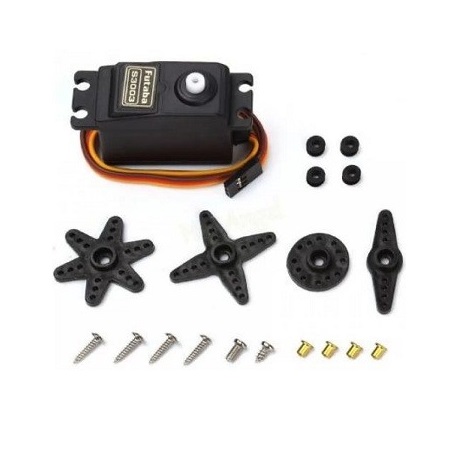 Specifications Modulation: Analog Torque: 4.8V: 44.00 oz-in (3.17 kg-cm) 6.0V: 57.00 oz-in (4.10 kg-cm) Speed: 4.8V: 0.23 sec/60° 6.0V: 0.19 sec/60° Weight: 1.31 oz (37.0 g) Dimensions: Length:1.57 in (39.9 mm) Width:0.79 in (20.1 mm) Height:1.42 in (36.1 mm) Gear Type: Plastic Rotation/Support: Bushing Rotational Range: 60° Pulse Cycle: 30 ms Pulse Width: 500-3000 µs Connector Type: J
Specifications Modulation: Analog Torque: 4.8V: 44.00 oz-in (3.17 kg-cm) 6.0V: 57.00 oz-in (4.10 kg-cm) Speed: 4.8V: 0.23 sec/60° 6.0V: 0.19 sec/60° Weight: 1.31 oz (37.0 g) Dimensions: Length:1.57 in (39.9 mm) Width:0.79 in (20.1 mm) Height:1.42 in (36.1 mm) Gear Type: Plastic Rotation/Support: Bushing Rotational Range: 60° Pulse Cycle: 30 ms Pulse Width: 500-3000 µs Connector Type: J -
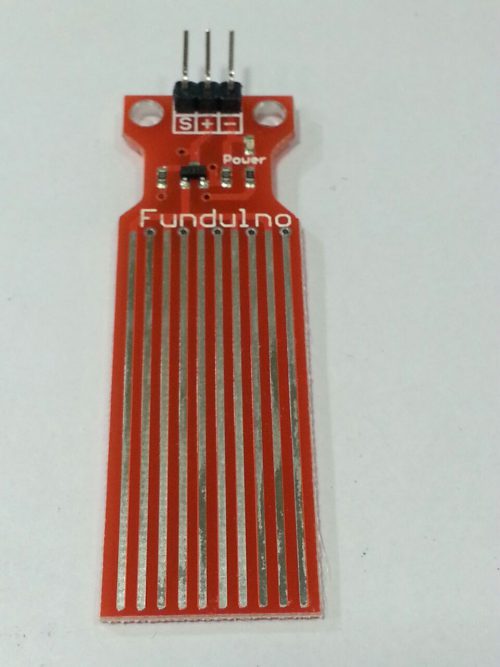 Water sensor brick is designed for water detection, which can be widely used in sensing rainfall, water level, and even liquid leakage. Water Detector / Sensor Connecting a water sensor to an Arduino is a great way to detect a leak, spill, flood, rain, etc. It can be used to detect the presence, the level, the volume and/or the absence of water. While this could be used to remind you to water your plants, there is a better Grove sensor for that. The sensor has an array of exposed traces, which read LOW when water is detected.
Water sensor brick is designed for water detection, which can be widely used in sensing rainfall, water level, and even liquid leakage. Water Detector / Sensor Connecting a water sensor to an Arduino is a great way to detect a leak, spill, flood, rain, etc. It can be used to detect the presence, the level, the volume and/or the absence of water. While this could be used to remind you to water your plants, there is a better Grove sensor for that. The sensor has an array of exposed traces, which read LOW when water is detected. -
 1.Output Current: 1.5A (min), 2.2A (typ) 2.Input-output voltage differential (VI-VO): 40Vdc (max) 3.Adjustable output voltage range: 1.2 ~ 37V 4.Operating temperature: -55 Celsius ~ 150 Celsius 5.Current output: 1.5A 6.Voltage Input: 4.2 ~ 40 V 7.Operating temperature: 0 Celsius ~ 125 Celsius 8.Characteristic frequency: 100MHz 9.Module size: 35.6 mm x16.8 mm 10.Input Method: VIN input is positive, GND Input Negative 11.Output: VOUT output positive, GND output negative
1.Output Current: 1.5A (min), 2.2A (typ) 2.Input-output voltage differential (VI-VO): 40Vdc (max) 3.Adjustable output voltage range: 1.2 ~ 37V 4.Operating temperature: -55 Celsius ~ 150 Celsius 5.Current output: 1.5A 6.Voltage Input: 4.2 ~ 40 V 7.Operating temperature: 0 Celsius ~ 125 Celsius 8.Characteristic frequency: 100MHz 9.Module size: 35.6 mm x16.8 mm 10.Input Method: VIN input is positive, GND Input Negative 11.Output: VOUT output positive, GND output negative -
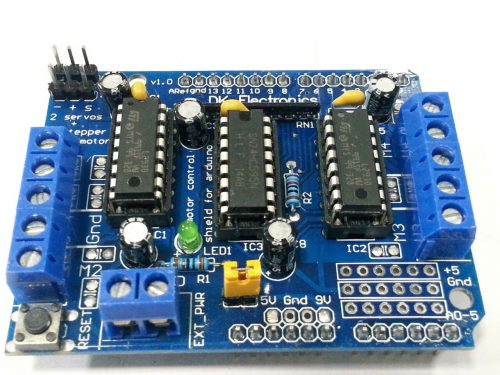 The Arduino Motor Shield is based on the L298, which is a dual full-bridge driver designed to drive inductive loads such as relays, solenoids, DC and stepping motors. It lets you drive two DC motors with your Arduino board, controlling the speed and direction of each one independently. You can also measure the motor current absorption of each motor, among other features.
The Arduino Motor Shield is based on the L298, which is a dual full-bridge driver designed to drive inductive loads such as relays, solenoids, DC and stepping motors. It lets you drive two DC motors with your Arduino board, controlling the speed and direction of each one independently. You can also measure the motor current absorption of each motor, among other features. -
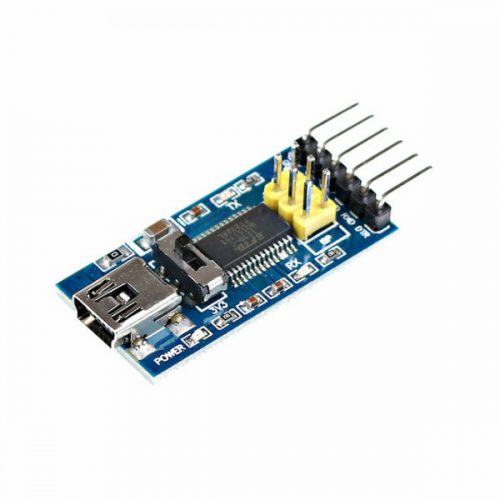 Feature: Chip: FT232RL Draw out all signal port of FT232RL chip RXD / TXD transceiver communication indicator USB power supply, can choose 5V or 3.3V, set by jumper With over current protection, using 500mA self-restore fuse Pin definition: DTR, RXD, TX, VCC, CTS, GND Pitch: 2.54mm Size: 36 x 18mm (L x W) Interface: Mini USB
Feature: Chip: FT232RL Draw out all signal port of FT232RL chip RXD / TXD transceiver communication indicator USB power supply, can choose 5V or 3.3V, set by jumper With over current protection, using 500mA self-restore fuse Pin definition: DTR, RXD, TX, VCC, CTS, GND Pitch: 2.54mm Size: 36 x 18mm (L x W) Interface: Mini USB -
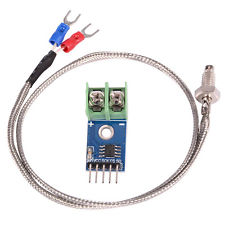 The MAX6675 performs cold-junction compensation and digitizes the signal from a type-K thermocouple. The data is output in a 12-bit resolution, SPI™-compatible, read-only format. This converter resolves temperatures to 0.25°C, allows readings as high as 1024°C, and exhibits thermocouple accuracy of 8LSBs for temperatures ranging from 0°C to 700°C. The MAX6675 is available in a small, 8-pin SO package.
The MAX6675 performs cold-junction compensation and digitizes the signal from a type-K thermocouple. The data is output in a 12-bit resolution, SPI™-compatible, read-only format. This converter resolves temperatures to 0.25°C, allows readings as high as 1024°C, and exhibits thermocouple accuracy of 8LSBs for temperatures ranging from 0°C to 700°C. The MAX6675 is available in a small, 8-pin SO package. -
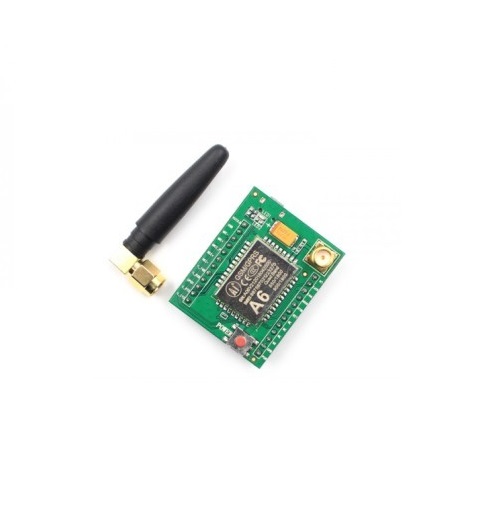 Operating temperature -30 to 80 Operating Voltage 3.3V-4.2V Power Voltage 3.4V Standby average current 3ma the following Stand by GSM / GPRS Four bands, including 850,900,1800,1900MHZ GPRS Class 10 Sensitivity -105 Support voice calls Stand by SMS SMS Stand by GPRS Data services, the maximum data rate, downloads 85.6Kbps, Upload 42.8Kbps Supports standard GSM07.07,07.05 AT Command and Ai Thinker Extended Command Stand by 2 A serial port, a serial port to download, a AT Command port AT Command supports standard AT and TCP / IP Command interface It supports digital audio and analog audio support HR , FR , EFR , AMR Speech coding Stand by ROHS , FCC , CE , CTA Certification SMT 42PIN Packaging
Operating temperature -30 to 80 Operating Voltage 3.3V-4.2V Power Voltage 3.4V Standby average current 3ma the following Stand by GSM / GPRS Four bands, including 850,900,1800,1900MHZ GPRS Class 10 Sensitivity -105 Support voice calls Stand by SMS SMS Stand by GPRS Data services, the maximum data rate, downloads 85.6Kbps, Upload 42.8Kbps Supports standard GSM07.07,07.05 AT Command and Ai Thinker Extended Command Stand by 2 A serial port, a serial port to download, a AT Command port AT Command supports standard AT and TCP / IP Command interface It supports digital audio and analog audio support HR , FR , EFR , AMR Speech coding Stand by ROHS , FCC , CE , CTA Certification SMT 42PIN Packaging -
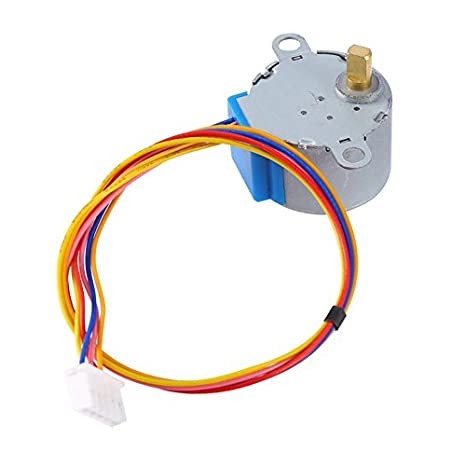 A unipolar stepper motor has one winding with center tap per phase. Each section of windings is switched on for each direction of magnetic field. Since in this arrangement a magnetic pole can be reversed without switching the direction of current, the commutation circuit can be made very simple (e.g., a single transistor) for each winding. Typically, given a phase, the center tap of each winding is made common: giving three leads per phase and six leads for a typical two phase motor. Often, these two phase commons are internally joined, so the motor has only five leads.
A unipolar stepper motor has one winding with center tap per phase. Each section of windings is switched on for each direction of magnetic field. Since in this arrangement a magnetic pole can be reversed without switching the direction of current, the commutation circuit can be made very simple (e.g., a single transistor) for each winding. Typically, given a phase, the center tap of each winding is made common: giving three leads per phase and six leads for a typical two phase motor. Often, these two phase commons are internally joined, so the motor has only five leads. -
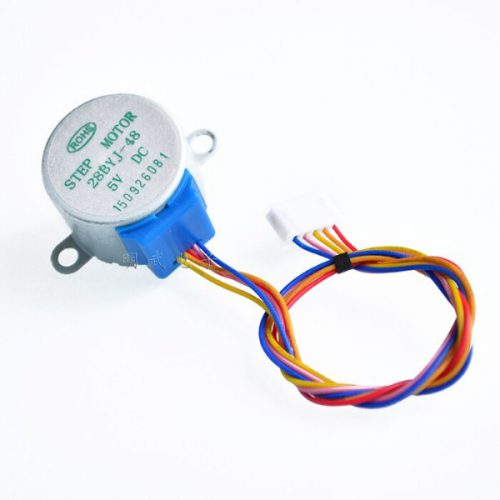 A unipolar stepper motor has one winding with center tap per phase. Each section of windings is switched on for each direction of magnetic field. Since in this arrangement a magnetic pole can be reversed without switching the direction of current, the commutation circuit can be made very simple (e.g., a single transistor) for each winding. Typically, given a phase, the center tap of each winding is made common: giving three leads per phase and six leads for a typical two phase motor. Often, these two phase commons are internally joined, so the motor has only five leads.
A unipolar stepper motor has one winding with center tap per phase. Each section of windings is switched on for each direction of magnetic field. Since in this arrangement a magnetic pole can be reversed without switching the direction of current, the commutation circuit can be made very simple (e.g., a single transistor) for each winding. Typically, given a phase, the center tap of each winding is made common: giving three leads per phase and six leads for a typical two phase motor. Often, these two phase commons are internally joined, so the motor has only five leads. -
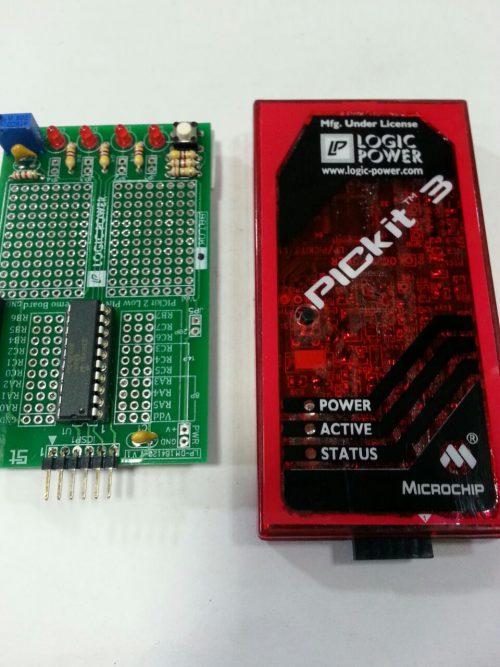 Microchip has gone on to manufacture the PICkit 3, a variation of the PICkit 2 with the same form factor and a new translucent case. It features a faster 16-bit PIC24F processor and a wider voltage regulation range. There are some complaints of it not being as reliable as the Pickit 2. Both PICkit 2 and PICkit 3 have internal, switch-mode voltage regulators. This allows them, in the case of the PICkit 2, to generate voltages from 2.5 to 5 volts, or in the case of the PICkit 3, 2.5 to 5.5 volts, from a 5 V USB supply, at around 100 mA. Both have options for calibrating the output with a multimeter, for increased accuracy. Additionally, for some PICs, the MCLR programming voltage can be generated, at around 13 to 14 volts. This voltage is required to reprogram the flash memory.
Microchip has gone on to manufacture the PICkit 3, a variation of the PICkit 2 with the same form factor and a new translucent case. It features a faster 16-bit PIC24F processor and a wider voltage regulation range. There are some complaints of it not being as reliable as the Pickit 2. Both PICkit 2 and PICkit 3 have internal, switch-mode voltage regulators. This allows them, in the case of the PICkit 2, to generate voltages from 2.5 to 5 volts, or in the case of the PICkit 3, 2.5 to 5.5 volts, from a 5 V USB supply, at around 100 mA. Both have options for calibrating the output with a multimeter, for increased accuracy. Additionally, for some PICs, the MCLR programming voltage can be generated, at around 13 to 14 volts. This voltage is required to reprogram the flash memory. -
 PICkit 2 has a separate programmer/debugger unit which plugs into the board carrying the chip to be programmed, whereas the PICkit 1 was a single unit. This makes it possible to use the programmer with a custom circuit board via an In Circuit Serial Programming (ICSP) header. This feature is not intended[3] for so-called "production" programming, however. The PICkit 2 uses an internal PIC18F2550 with FullSpeed USB. The latest PICkit 2 firmware allows the user to program and debug most of the 8 and 16 bit PICmicro and dsPIC members of the Microchip product line. The PICkit 2 is open to the public, including its hardware schematic, firmware source code (in C language) and application programs (in C# language). End users and third parties can easily modify both the hardware and software for enhanced features. e.g. Linux version of PICkit 2 application software, DOS style CMD support, etc.
PICkit 2 has a separate programmer/debugger unit which plugs into the board carrying the chip to be programmed, whereas the PICkit 1 was a single unit. This makes it possible to use the programmer with a custom circuit board via an In Circuit Serial Programming (ICSP) header. This feature is not intended[3] for so-called "production" programming, however. The PICkit 2 uses an internal PIC18F2550 with FullSpeed USB. The latest PICkit 2 firmware allows the user to program and debug most of the 8 and 16 bit PICmicro and dsPIC members of the Microchip product line. The PICkit 2 is open to the public, including its hardware schematic, firmware source code (in C language) and application programs (in C# language). End users and third parties can easily modify both the hardware and software for enhanced features. e.g. Linux version of PICkit 2 application software, DOS style CMD support, etc. -
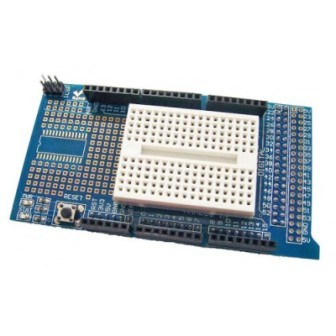 The Mega2560 Shield makes it easy for you to design custom circuits. You can solder parts to the prototyping area to create your project, or use it with a small solderless breadboard to quickly test circuit ideas without having to solder. It's got extra connections for all of the Arduino I/O pins, and it's got space to mount through-hole and surface mount integrated circuits. It's a convenient way to make your custom circuit and Arduino into a single module.
The Mega2560 Shield makes it easy for you to design custom circuits. You can solder parts to the prototyping area to create your project, or use it with a small solderless breadboard to quickly test circuit ideas without having to solder. It's got extra connections for all of the Arduino I/O pins, and it's got space to mount through-hole and surface mount integrated circuits. It's a convenient way to make your custom circuit and Arduino into a single module.


